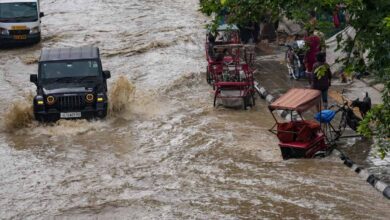Swelling Yamuna reaches iconic Taj Mahal walls after 45 years, floods garden

Swelling Yamuna reaches iconic Taj Mahal walls after 45 years, floods garden
The recent heavy rains in the region have caused a significant increase in the water level of the Yamuna River, resulting in adverse effects on the Taj Mahal and its surroundings in Agra. According to a report by The Times of India, the rising waters of the Yamuna River reached the walls of the Taj Mahal on Monday, submerging a garden behind the monument. This sight has not been witnessed in 45 years, with the last occurrence happening during the floods of 1978. The water level exceeded the “low-flood level” of 495 feet, reaching a higher point.
The situation poses a significant concern for the preservation and protection of the Taj Mahal, a UNESCO World Heritage site and one of India’s most iconic landmarks. The flooding not only affects the immediate surroundings of the monument but also raises potential risks to its structural integrity and the overall environment.
Efforts are underway to mitigate the impact of the flooding and protect the Taj Mahal from further damage. Authorities closely monitor the situation and implement measures to address the waterlogging and associated challenges.
It is crucial to prioritize the preservation and conservation of the Taj Mahal, which holds immense historical and cultural significance. This includes taking necessary steps to manage and mitigate the impact of natural phenomena such as flooding to ensure the long-term protection of this architectural masterpiece.
According to the report, the recent increase in the water level of the Yamuna River has not only affected the Taj Mahal but also raised concerns about the safety of other historical monuments in the area. Sites such as Rambagh, Mehtab Bagh, Zohra Bagh, Kala Gumbad, and Chini ka Rauza are near the Taj Mahal and are also vulnerable to the flooding.
However, the Archaeological Survey of India (ASI) has provided reassurance that these monuments have not suffered any damage thus far. Despite the rising water levels, the ASI has been closely monitoring the situation and has implemented measures to protect these historical sites from potential harm. Their efforts have ensured that these monuments remain unharmed despite the challenging circumstances.
Unfortunately, the adjacent Dussehra Ghat and Itimad-ud-Daula’s tomb have experienced flooding due to the increased water levels. These areas have been affected by the overflow of the Yamuna River, which has submerged parts of the ghat and posed risks to the tomb’s surroundings.
The safety and preservation of these historical monuments are of utmost importance. The ASI, along with local authorities, continues to monitor the situation and undertake necessary actions to safeguard these sites. Efforts are being made to prevent further damage and ensure that the necessary steps are taken to mitigate the impact of the flooding.
It is crucial to maintain the integrity and cultural significance of these monuments, as they are valuable heritage sites that attract tourists from around the world. The government and relevant authorities must prioritize the protection and conservation of these historical treasures, implementing sustainable measures to mitigate the risks posed by natural disasters such as flooding.According to officials from the Archaeological Survey of India (ASI), the Taj Mahal has demonstrated its resilience during the recent flooding due to its ingenious design. The main mausoleum of the Taj Mahal was carefully planned to withstand floodwaters, ensuring that water cannot enter the main structure, even during high floods.
Prince Vajpayee, a conservation assistant at ASI, highlighted that the monument’s meticulous design accounts for the potential of flooding. The architectural features and engineering techniques employed in the construction of the Taj Mahal aim to protect the main structure from water damage. This design consideration has contributed to the monument’s ability to withstand the recent Yamuna River water level surge.
The ASI’s assurance regarding the Taj Mahal’s resilience during flooding is a testament to this iconic monument’s architectural brilliance and planning. The careful consideration of potential natural hazards, such as high floods, has allowed the Taj Mahal to remain protected and preserved over the centuries.
It is important to recognize the expertise and knowledge applied by the architects and engineers who designed the Taj Mahal, ensuring its ability to withstand various environmental challenges. This underscores the significance of incorporating sustainable and resilient design principles in the construction and preservation of historical structures.During the severe flooding in 1978, the water level of the Yamuna River rose to 508 feet, exceeding the high-flood level in Agra.
At that time, the floodwaters managed to enter 22 rooms located in the basement of the Taj Mahal, leaving behind silt. This incident prompted the Archaeological Survey of India (ASI) to take precautionary measures to prevent similar occurrences.
To address the issue, the ASI implemented specific actions. Firstly, they removed the wooden doors that had previously allowed water to enter the monument during floods. By eliminating these entry points, the ASI aimed to block the passage of floodwaters into the Taj Mahal’s interior.
Additionally, the ASI constructed walls at the entrances from Basai and Dussehra ghats. These walls served as barriers to prevent floodwaters from directly accessing the monument’s basement and other sensitive areas.
These measures were implemented to enhance the protection and preservation of the Taj Mahal during periods of heavy rainfall and flooding. By removing the previous entry points and constructing additional barriers, the ASI aimed to minimize the risk of water entering the monument and causing damage or leaving behind silt.
These actions demonstrate the ongoing commitment of the ASI to safeguard the Taj Mahal from potential flood-related risks. The continuous efforts to adapt and improve the protective measures based on past experiences underline the importance placed on preserving this iconic World Heritage site.Following the flood caused by the rising water level of the Yamuna River, rescue operations were initiated by teams from the National Disaster Response Force (NDRF), local police, and the administration. These teams worked tirelessly to evacuate over 500 individuals from 50 villages and 20 urban areas situated near the banks of the Yamuna.

The objective was to ensure the safety of these residents by relocating them to safer locations away from the flood-affected areas.
The efforts of the rescue teams were focused on swiftly responding to the emergency situation and providing assistance to those affected. The NDRF, police, and local administration collaborated to execute the evacuation operations effectively and efficiently. Their prompt actions were instrumental in safeguarding the lives of the affected individuals and minimizing the risks associated with the flood.
In addition to Agra, the neighboring Mathura district also experienced a surge in the water level of the Yamuna River. The water level in Mathura reached 167.28 meters, surpassing the danger mark of 166 meters. This situation necessitated heightened vigilance and coordinated efforts to mitigate the impact of the flood in the district.
The rescue operations and evacuation efforts reflect the priority given to the safety and well-being of the communities residing in the flood-affected areas. The combined efforts of the NDRF, police, and local administration played a crucial role in successfully evacuating the residents and relocating them to safer places until the flood situation subsided.
It is important to recognize the significance of such coordinated rescue operations, as they demonstrate the commitment of the authorities to protect the lives of citizens during natural calamities like floods.
The timely response and effective implementation of evacuation plans contribute to minimizing the potential loss of life and ensuring the safety of the affected population.Regrettably, the flooding incident resulted in significant damage to agricultural lands in Agra and Mathura districts. The deluge submerged over 500 bighas (approximately 200 hectares) of agricultural land, impacting the livelihoods of farmers in the region. The inundation of farmland can have severe consequences for the agricultural sector, affecting crop yields and causing economic hardships for farmers.

In addition to the agricultural damage, the flood also disrupted essential services in the affected areas. Around 100 villages and urban localities experienced power outages for two days, depriving residents of electricity. This lack of electricity can disrupt daily life, impacting various aspects such as communication, access to basic amenities, and the ability to carry out daily tasks.
Furthermore, the flood-affected areas of Mathura faced shortages of ration (food supplies) and drinking water. These scarcities can lead to challenges in meeting the basic needs of the residents, exacerbating the difficulties caused by the flood. The shortage of essential supplies further emphasizes the urgency of providing relief and support to those affected by the flood.
The damage to agricultural lands, power outages, and shortages of essential supplies highlight the far-reaching consequences of the flood on the affected communities. It underscores the need for comprehensive relief efforts that address not only immediate concerns such as food and water shortages but also support the long-term recovery and rehabilitation of the affected regions.
Efforts from the local administration, government agencies, and humanitarian organizations are essential to providing necessary relief and ensuring the well-being of the affected communities. This can include the provision of food, clean water, temporary shelter, and assistance in restoring power supply and infrastructure.Despite the resilience of the Taj Mahal against the rising river, the overall situation in the region remains critical. The impact of the flooding extends beyond the monument, affecting communities in the surrounding areas. Efforts are currently underway to provide assistance and support to the affected communities while working towards mitigating further damage.

Local authorities, government agencies, and relief organizations are actively involved in addressing the challenges posed by the flood. Their focus is on providing immediate relief to those affected, including the provision of essential supplies such as food, clean water, and temporary shelter. These efforts aim to meet the immediate needs of the affected communities and ensure their well-being during this difficult time.
Additionally, measures are being taken to mitigate further damage and prevent future flooding-related risks. This includes closely monitoring the water levels, strengthening embankments, and improving drainage systems to better manage water flow during heavy rainfall.
The collaboration between various stakeholders, including local authorities, government agencies, and relief organizations, is crucial in effectively responding to the situation. Their coordinated efforts ensure that support reaches the affected communities promptly and efficiently.
It is essential to continue monitoring the situation closely and adapt response strategies as needed. The focus remains on addressing the immediate needs of the affected communities, providing relief, and working towards the long-term recovery and rehabilitation of the region.






